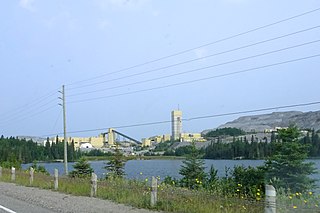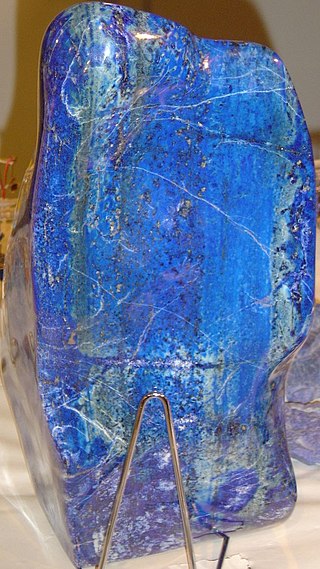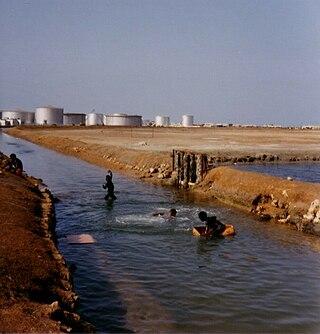
Mining is the extraction of valuable geological materials from the Earth and other astronomical objects. Mining is required to obtain most materials that cannot be grown through agricultural processes, or feasibly created artificially in a laboratory or factory. Ores recovered by mining include metals, coal, oil shale, gemstones, limestone, chalk, dimension stone, rock salt, potash, gravel, and clay. The ore must be a rock or mineral that contains valuable constituent, can be extracted or mined and sold for profit. Mining in a wider sense includes extraction of any non-renewable resource such as petroleum, natural gas, or even water.

Barrick Gold Corporation is a mining company that produces gold and copper with 16 operating sites in 13 countries. It is headquartered in Toronto, Ontario, Canada. It has mining operations in Argentina, Canada, Chile, Côte d'Ivoire, Democratic Republic of the Congo, Dominican Republic, Mali, Papua New Guinea, Saudi Arabia, Tanzania, the United States and Zambia. In 2019, it produced 5.5 million ounces of gold at all-in sustaining costs of $894/ounce and 432 million pounds of copper at all-in sustaining costs of $2.52/pound. As of 31 December 2019, the company had 71 million ounces of proven and probable gold reserves.

Rio Tinto Group is an Anglo-Australian multinational company that is the world's second-largest metals and mining corporation. The company was founded in 1873 when a group of investors purchased a mine complex on the Rio Tinto, in Huelva, Spain, from the Spanish government. It has grown through a long series of mergers and acquisitions. Although primarily focused on extraction of minerals, Rio Tinto also has significant operations in refining, particularly the refining of bauxite and iron ore. Rio Tinto has joint head offices in London and Melbourne.

Mining in Japan is minimal because Japan does not possess many on-shore mineral resources. Many of the on-shore minerals have already been mined to the point that it has become less expensive to import minerals. There are small deposits of coal, oil, iron and minerals in the Japanese archipelago. Japan is scarce in critical natural resources and has been heavily dependent on imported energy and raw materials. There are major deep sea mineral resources in the seabed of Japan. This is not mined yet due to technological obstacles for deep sea mining.
Aluminum Corporation of China Limited, is a Chinese company listed in Hong Kong and in New York. A multinational aluminium company, its headquarters are in Beijing, People's Republic of China. It is the world's second-largest alumina producer and third-largest primary aluminium producer.

Mining in Western Australia, together with the petroleum industry in the state, accounted for 94% of the State's and 46% of Australia's income from total merchandise exports in 2019–20. The state of Western Australia hosted 123 predominantly higher value and export-oriented mining projects and hundreds of smaller quarries and mines. The principal projects produced more than 99 per cent of the industry's total sales value.

Mining in Iran is still under development, yet the country is one of the most important mineral producers in the world, ranked among 15 major mineral-rich countries, holding some 68 types of minerals, 37 billion tonnes of proven reserves and more than 57 billion tonnes of potential reserves worth $770 billion in 2014. Mineral production contributes only 0.6 percent to the country's GDP. Add other mining-related industries and this figure increases to just four percent (2005). Many factors have contributed to this, namely lack of suitable infrastructure, legal barriers, exploration difficulties, and government control.

The mining industry of the Democratic Republic of the Congo produces copper, diamonds, tantalum, tin, gold, and more than 63% of global cobalt production. Minerals and petroleum are central to the DRC's economy, making up more than 95% of the value of its exports.
Lundin Mining Corporation is a Canadian company that owns and operates mines in Sweden, United States, Chile, Portugal and Brazil that produce base metals such as copper, zinc, and nickel. Headquartered in Toronto, the company was founded by Adolf Lundin and operated by Lukas Lundin. While it was incorporated to pursue an interest in a diamond mine in Brazil, the company re-structured and raised funds to develop the Storliden mine in Sweden. It purchased the Swedish Zinkgruvan Mine from Rio Tinto and then merged with Arcon International Resources for its Galmoy Mine in Ireland and Eurozinc for its Neves-Corvo mine in Portugal. The company subsequently purchased and operated the Eagle mine, Candelaria mine, and Chapada mine.

Mining in Afghanistan was controlled by the Ministry of Mines and Petroleum, prior to the August 15th takeover by the Taliban. It is headquartered in Kabul with regional offices in other parts of the country. Afghanistan has over 1,400 mineral fields, containing barite, chromite, coal, copper, gold, iron ore, lead, natural gas, petroleum, precious and semi-precious stones, salt, sulfur, lithium, talc, and zinc, among many other minerals. Gemstones include high-quality emeralds, lapis lazuli, red garnet and ruby. According to a joint study by The Pentagon and the United States Geological Survey, Afghanistan has an estimated US$1 trillion of untapped minerals.

The mineral industry is one of the main sectors of the Armenian economy and in 2017 accounted for 30.1% of its exports.
The 2000s commodities boom or the commodities super cycle was the rise of many physical commodity prices during the early 21st century (2000–2014), following the Great Commodities Depression of the 1980s and 1990s. The boom was largely due to the rising demand from emerging markets such as the BRIC countries, particularly China during the period from 1992 to 2013, as well as the result of concerns over long-term supply availability. There was a sharp down-turn in prices during 2008 and early 2009 as a result of the credit crunch and European debt crisis, but prices began to rise as demand recovered from late 2009 to mid-2010.
The Golden Grove mine is a copper, lead, silver, zinc and gold mine located 52 km south-southeast of Yalgoo, Western Australia. It is operated by 29Metals Limited after a 2021 divestment by EMR Capital.

MMG Limited is a mid-tier global resources company that mines, explores and develops base metal projects around the world. MMG's largest shareholder is China Minmetals with 68%.
Equinox Minerals is a mining and exploration company with corporate offices in Perth, Australia and Toronto, Ontario, Canada. It has operations in Peru and Australia. In Zambia it owned the Lumwana Mining Company, but that was bought by Barrick Gold in 2011. Through Liontown Resources Limited and Alturas Minerals Corp., the company has gold and copper-gold exploration interests in Peru and Australia. The Lumwana project which had enough reserves to be productive for 37 years, cost the company one billion dollars to develop. In Zambia it has been credited with supporting social development through projects which aim to build schools, attract professionals to areas around its mine sites. 2010 copper production was 323.4 million pounds 68% higher than in 2009.

Anvil Mining was a copper producer that has been operating in the Democratic Republic of the Congo (DRC) from 2002 to 2012. The company headquarters were in Montreal, Quebec, Canada. Anvil was listed on the Toronto Stock Exchange and the Australian Stock Exchange. As of September 2011 its major shareholder was Trafigura Beheer.
Kinsevere is an open pit mine and Heavy Media Separation plant with an electric arc furnace formerly operated by Anvil Mining, and now operated by Minerals and Metals Group. It is located 30 kilometres (19 mi) north of Lubumbashi, Katanga Province, Democratic Republic of Congo.
Mining in North Korea is important to the country's economy. North Korea is naturally abundant in metals such as magnesite, zinc, tungsten, and iron; with magnesite resources of 6 billion tonnes, particularly in the North and South Hamgyong Province and Chagang Province. However, often these cannot be mined due to the acute shortage of electricity in the country, as well as the lack of proper tools to mine these materials and an antiquated industrial base. Coal, iron ore, limestone, and magnesite deposits are larger than other mineral commodities. Mining joint ventures with other countries include China, Canada, Egypt, and South Korea.

The mining industry of Sudan is mostly driven by extraction fuel minerals, with petroleum accounting for a substantial contribution to the country's economy, until the autonomous region of Southern Sudan became an independent country in July 2011. Gold, iron ore, and base metals are mined in the Hassai Gold Mine and elsewhere. Chromite is another important mineral extracted from the Ingessana Hills. Other minerals extracted are gypsum, salt, and cement. Phosphate is found in Mount Kuoun and Mount Lauro in eastern Nuba. Reserves of zinc, lead, aluminium, cobalt, nickel in the form of block sulfides, and uranium are also established. Large reserves of iron ore have been established.
The Mining industry of Laos which has received prominent attention with foreign direct investments (FDI) has, since 2003–04, made significant contributions to the economic condition of Laos. More than 540 mineral deposits of gold, copper, zinc, lead and other minerals have been identified, explored and mined. During 2012, the mining and quarrying sector's contribution to GDP was around 7.0%; during this reporting year the FDI in the mineral sector was of the order of US$662.5 million out of a total trade of $4.7 billion in the country. Laos is now a member of the WTO.













